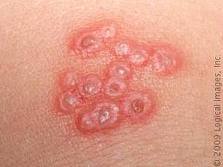Background
Herpes simplex virus (HSV) is a double-stranded, enveloped, DNA virus. Herpes simplex virus type 1 (HSV-1) and herpes simplex virus type 2 (HSV-2) belong to the family Herpesviridae, subfamily Alphaherpesvirinae. The herpes viruses are characterized by their propensity for latency in sensory neural ganglia. The site of latency is the trigeminal ganglion in HSV-1 infection1 and the sacral ganglion in HSV-2 infection. Herpes simplex virus infections are ubiquitous and cause a wide range of infections from isolated mucocutaneous lesions to disseminated infection in all age groups. Neonatal herpes simplex virus disease is associated with high morbidity and mortality.2 Herpes simplex virus infections are among the few non-HIV viral infections amenable to antiviral therapy. Available antiviral chemotherapy can be used to treat infection, shorten the clinical course, and, in certain circumstances, prevent infection with herpes simplex virus.

